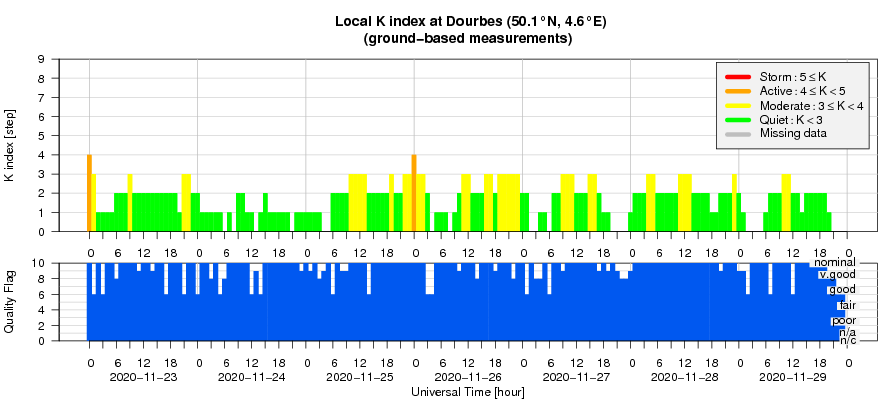- Table of Content
- 1.SOHO celebrate...
- 2.New milestones...
- 3.Review of sola...
- 4.The Internatio...
- 5.PROBA2 Observa...
- 6.Noticeable Sol...
- 7.Review of geom...
- 8.Geomagnetic Ob...
- 9.The SIDC Space...
- 10.Review of iono...
- 11.Not relevant
2. New milestones reached by young SC25
3. Review of solar activity
4. The International Sunspot Number by Silso
5. PROBA2 Observations (23 Nov 2020 - 29 Nov 2020)
6. Noticeable Solar Events (23 Nov 2020 - 29 Nov 2020)
7. Review of geomagnetic activity
8. Geomagnetic Observations at Dourbes (23 Nov 2020 - 29 Nov 2020)
9. The SIDC Space Weather Briefing
10. Review of ionospheric activity (23 Nov 2020 - 29 Nov 2020)
11. Not relevant
SOHO celebrates its 25th anniversary
Today, on 2 December 2020, the Solar and Heliospheric Observatory (SOHO) celebrates its 25th anniversary. Since its launch in 1995, this versatile spacecraft has earned its place in the space weather Hall-of-Fame, providing space weather forecasters a solid base to build on. Indeed, with its -at that time- high cadence EUV and white light imagery and coronagraphic images, it brought space weather monitoring and forecasting to a whole new level. As an STCE scientist puts it: "SOHO is THE satellite that allowed space weather to exist as we know it today."
SOHO, a combined ESA/NASA project, revolutionized space weather monitoring by providing imagery of the Sun in white light, 4 wavelengths in extreme ultraviolet (EUV), and magnetograms at a cadence of several images per hour. Its coronagraphs provided a view of the immediate surroundings of the Sun, allowing a good view on the ominous coronal mass ejections. More importantly, these images were available in near real-time, something unseen up to that time.
An icon in solar and heliospheric research, SOHO instruments have contributed to several other research domains, such as the solar wind (parameters, origin) or the solar interior (oscillations). There have been very few satellites that played such a groundbreaking role in a research domain than SOHO. The spacecraft is also the best comet chaser in history, having made its 4000th (four thousand!) comet discovery just a few months ago (15 June 2020 - see the NASA bulletin at https://www.nasa.gov/feature/goddard/2020/4000th-comet-discovered-by-esa-nasa-solar-observatory).
SOHO also has a special place in the heart of the STCE. Indeed, SOHO/EIT (EUV Imaging Telescope) was the start of the Belgian PRODEX program and the start of the space age at SIDC (http://www.sidc.be/ ). The PROgramme for the Development of scientific EXperiments (PRODEX) is a programme of ESA in which Belgium, as member state of ESA, has been participating since 29 June 1988. Dr Frederic Clette, the current head of SILSO (http://sidc.oma.be/silso/ ) was the first EIT PRODEX-postdoc at the Royal Observatory of Belgium (ROB). EIT was the first EUV imager in which the STCE got involved: The Solar Physics Department of the Royal Observatory of Belgium (ROB) and the Centre Spatial de Liege (CSL - https://www.csl.uliege.be/cms/c_10241774/en/csl ) contributed to the instrument development, calibration and in-flight control (see this SIDC page at http://sidc.oma.be/EIT/ ). This tradition continued with PROBA2/SWAP and Solar Orbiter/EUI. Indirectly, the EIT experience also made the emergence of space weather operations at ROB possible.
SOHO had a near-death experience in 1998 after a loss of control on 24 June. Fortunately, using the late ARECIBO radio telescope on Puerto Rico (see this NATURE article at https://www.nature.com/articles/d41586-020-03270-9 ), ground controllers heroically regained contact with and control of the spacecraft over the next few months (see this NASA bulletin at https://science.nasa.gov/science-news/science-at-nasa/1998/ast28jul98_1 ). It's the longest single period in SOHO's operational life without imagery, and it became known as "SOHO's holiday". Eventually, this workhorse of the solar scientists and space weather specialists would become superseded by the Solar Dynamics Observatory in 2010, which had a much higher resolution and image cadence. However, the telemetry gained by stopping SOHO's solar disk imagery was used to boost the cadence of the coronagraphic images to one image every 12 minutes, for both coronagraphs. That is why, up to this day, SOHO remains the main spacecraft delivering the so critical coronagraphic imagery.
A clip with some of the most iconic images made by the SOHO instruments can be found at the STCE webpage http://www.stce.be/news/505/welcome.html There's also a small movie (https://youtu.be/GrUqcyPerXI ) containing a selection of the most spectacular events observed by SOHO. NASA/GSFC also released an incredible movie of coronagraphic images taken by SOHO since 1998, available at YouTube (https://www.youtube.com/watch?v=o-DHwNFDgOU&list=LL&index=2). More information, imagery,... can be found on the SOHO website (https://sohowww.nascom.nasa.gov/home.html ).
Many congratulations to the SOHO team and all who contributed to this ongoing and incredibly successful solar mission!

New milestones reached by young SC25
Several sunspot groups were visible last week, with on 29 November no less than 6 groups at the same time. This drove the International Sunspot Number (ISN) to levels near 100, a value not seen since the last episode of major solar activity back in September 2017 (See the STCE Newsitems here http://www.stce.be/news/400/welcome.html and here http://www.stce.be/news/402/welcome.html ). The main sunspot group was NOAA 2786, of which the largest spot was reported visible to the naked eye by several solar observers (using eclipse glasses of course!). On top of that, according to the daily USAF/NOAA Solar Region Summaries (ftp://ftp.swpc.noaa.gov/pub/forecasts/SRS/ ), NOAA 2786 was also the first group of solar cycle 25 (SC25) to reach an area of 1000 MH. This is again a value not seen for a single sunspot region since the big groups from September 2017 (NOAA 2673 on 9 September, 1060 MH). Note that 1000 MH ("millionths of a solar hemisphere") correspond to about 3000 million square kilometers, or roughly 6 times the entire surface of the Earth.
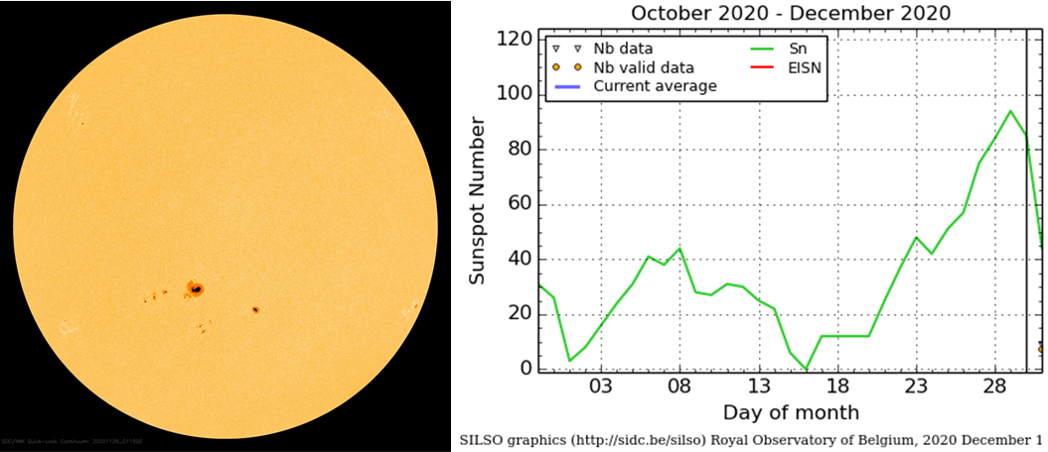
The presence of so many sunspots also drove the observed 10.7cm solar radio flux above the 100 sfu (solar flux units, with 1 sfu = 10-22 W m-2 Hz-1) level, for the first time this solar cycle. It reached a maximum value of 116.3 sfu on 29 November, the same day the (preliminary) ISN reached its maximum value of 94. These are again values not seen in more than 3 years.
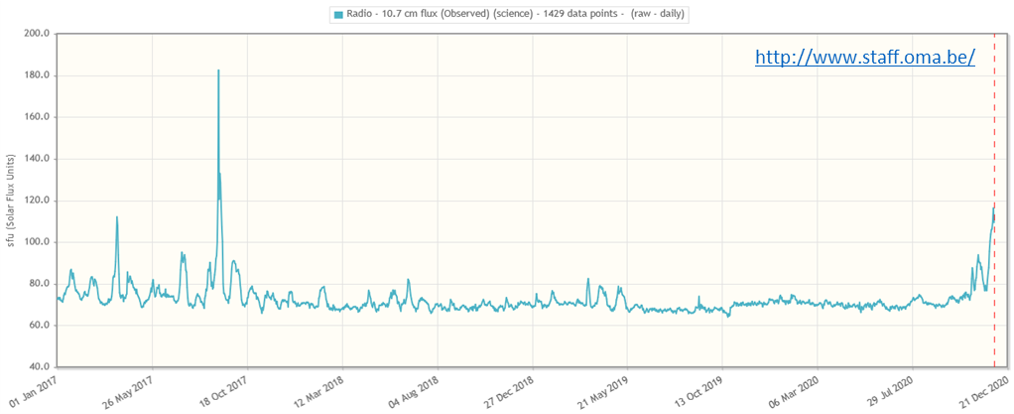
Despite their size, these regions had relatively simple magnetic configurations and produced only C-class flares. Yet, on 29 November a strong long duration M4.4 flare was produced by a region that was still behind the southeast limb on 29 November. Despite its location, post-flare coronal loops quickly towered 65.000 km above the solar limb, as can be seen SDO/AIA 171 extreme ultraviolet imagery underneath (https://sdo.gsfc.nasa.gov/data/aiahmi/ ). The associated coronal mass ejection (CME) was the fastest so far this solar cycle, with a speed of around 1250 km/s. As such, it belonged to the O-class ("occasional") on the SCORE-scale for CME speeds (see the NASA website at https://swc.gsfc.nasa.gov/main/score ). This CME is thought to be mostly directed away from the Earth in view of its farside location.
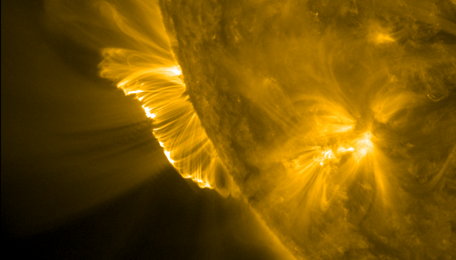
Also the first halo CME of SC25 was observed last week. On 24 November, an asymmetric halo was recorded around the Sun in coronagraphic imagery by the SOHO/LASCO instrument (https://sohowww.nascom.nasa.gov/ ), as can be seen in the CACTus (http://www.sidc.oma.be/cactus/ ) difference imagery underneath ("difference" means one image subtracted from the previous one). The all-in-all faint CME originated from a source on the farside of the Sun ans so it was not directed to Earth. The halo is labeled "asymmetric" because the Sun is not nicely in the centre of the halo, but a bit to the right. This means that the source region of the CME was not exactly on the Earth-Sun line, but slightly to the east ("left") of this line. Clips of the post-flare coronal loops and the CME can be found at http://www.stce.be/news/506/welcome.html
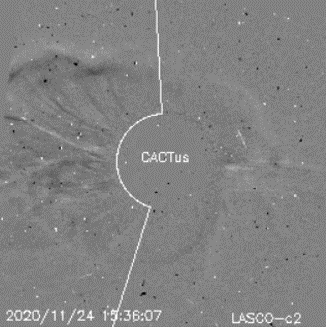
Review of solar activity
Solar activity was at low levels.
Over the week there were in total seven active regions (ARs), NOAA AR 2783 to NOAA 2789. The majority of the active regions did not produce any significant flares and were magnetically simple. The most flaring activity was produced by NOAA ARs 2785 and 2756, which produced multiple low-level C-class flares, the largest of which was a C4.3 flare on November 23. There was also a C2 flare observed over the north-east solar limb, which was associated with a non Earth-directed Coronal Mass Ejection (CME).
The daily 10.7cm solar radio flux increased over the week, from an initial value of 88 to 116 sfu by the end of the period.
No earth-directed CMEs were observed.
The greater than 10 MeV proton flux was at nominal values.
The greater than 2 MeV electron flux was frequently above the 1000 pfu alert threshold.
The greater than 2 MeV electron fluence was at moderate levels for the much of the week.
The International Sunspot Number by Silso
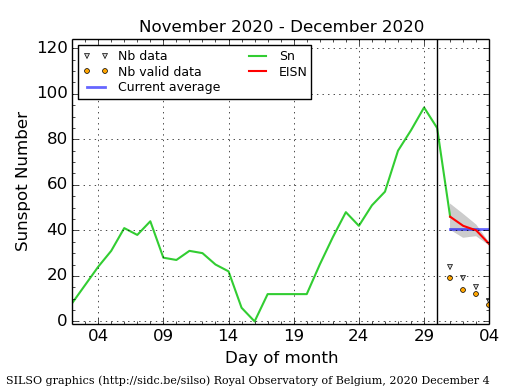
The daily Estimated International Sunspot Number (EISN, red curve with shaded error) derived by a simplified method from real-time data from the worldwide SILSO network. It extends the official Sunspot Number from the full processing of the preceding month (green line). The plot shows the last 30 days (about one solar rotation). The horizontal blue line shows the current monthly average. The yellow dots gives the number of stations that provided valid data. Valid data are used to calculate the EISN. The triangle gives the number of stations providing data. When a triangle and a yellow dot coincide, it means that all the data is used to calculate the EISN of that day.
PROBA2 Observations (23 Nov 2020 - 29 Nov 2020)
Solar Activity
Solar flare activity fluctuated between low and moderate during the week.
In order to view the activity of this week in more detail, we suggest to go to the following website from which all the daily (normal and difference) movies can be accessed: https://proba2.oma.be/ssa
This page also lists the recorded flaring events.
A weekly overview movie can be found here (SWAP week 557): https://proba2.sidc.be/swap/data/mpg/movies/weekly_movies/weekly_movie_2020_11_23.mp4
Details about some of this week's events can be found further below.
If any of the linked movies are unavailable they can be found in the P2SC movie repository here: https://proba2.oma.be/swap/data/mpg/movies/
Thursday Nov 26
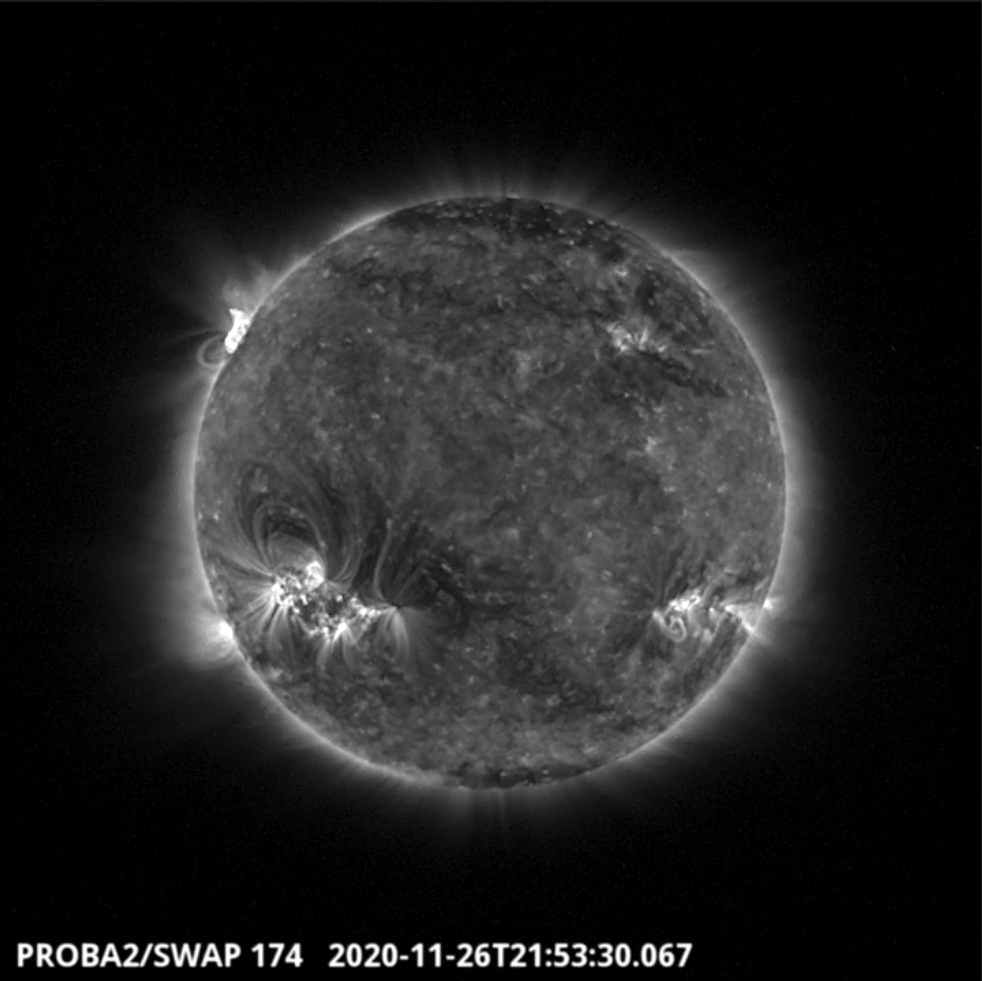
An eruption associated with a C2.6 flare was observed by SWAP near the north-eastern limb of the Sun on 2020-Nov-26, as shown in the SWAP image above taken at 21:53 UT.
Find a movie of the event here: https://proba2.sidc.be/swap/movies/20201126_swap_movie.mp4 (SWAP movie) and here: https://proba2.sidc.be/swap/movies/20201126_swap_diff.mp4 (SWAP difference movie).
Sunday Nov 29
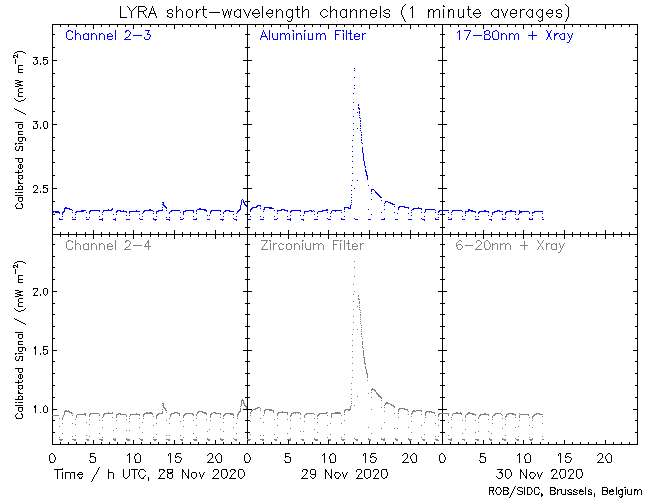
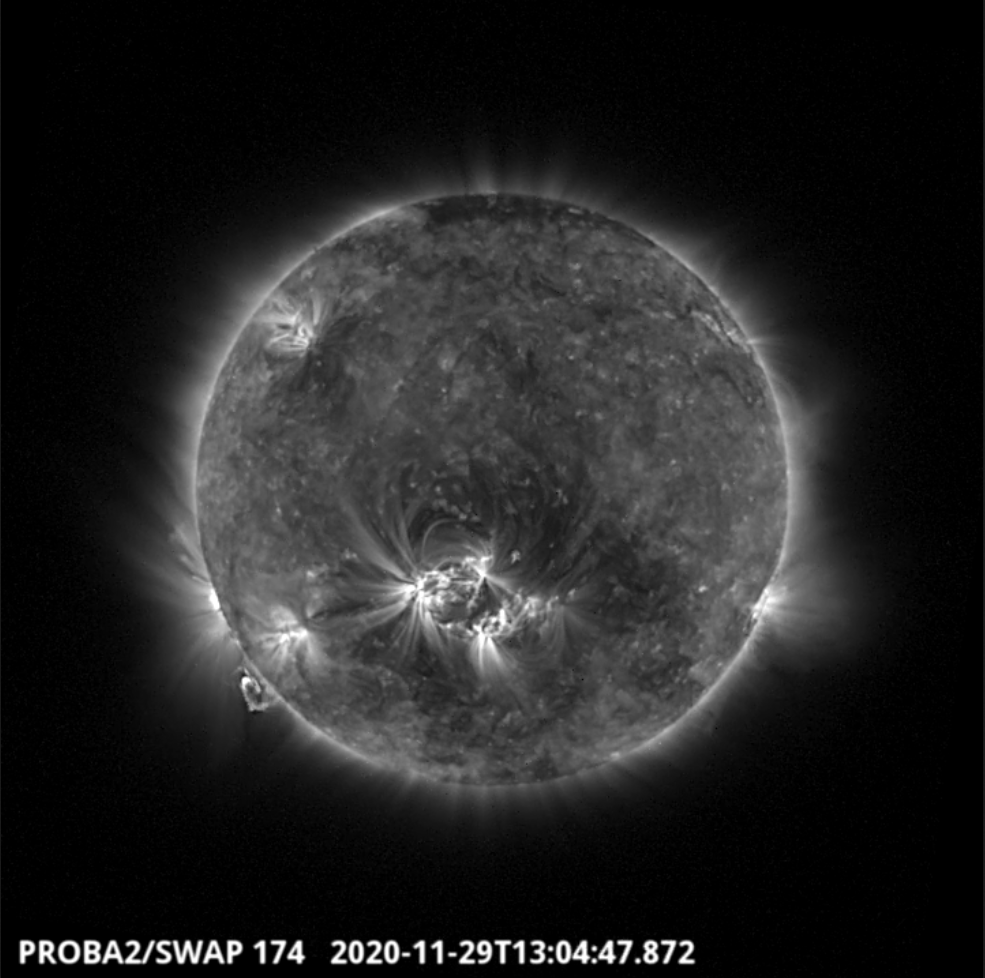
An M4.4 flare was observed by SWAP and LYRA on 2020-Nov-29, the flare occurred on the south-eastern limb of the Sun, as shown in the SWAP image above taken at 13:04 UT.
Find a movie of the event here: https://proba2.sidc.be/swap/movies/20201129_swap_movie.mp4 (SWAP movie) and here: https://proba2.sidc.be/swap/movies/20201129_swap_diff.mp4 (SWAP difference movie).
Noticeable Solar Events (23 Nov 2020 - 29 Nov 2020)
| DAY | BEGIN | MAX | END | LOC | XRAY | OP | 10CM | TYPE | Cat | NOAA |
| 29 | 1234 | 1311 | 1341 | M4.4 | 240 | VI/2II/2III/1 |
| LOC: approximate heliographic location | TYPE: radio burst type |
| XRAY: X-ray flare class | Cat: Catania sunspot group number |
| OP: optical flare class | NOAA: NOAA active region number |
| 10CM: peak 10 cm radio flux |
Review of geomagnetic activity
Solar wind parameters were at elevated levels at the start of the week as the Earth continued to be under the influence of the high-speed stream associated with the extension to the northern polar coronal hole (CH), which traversed the central meridian on November 19.
Over the week, the solar wind speed declined from 650 to 400 km/s, with a few slight enhancements on 26-28 November due to the influence from a second extension of the northern polar CH. Bz varied between -7 and +6 nT.
The direction of the interplanetary magnetic field was in a predominantly directed away from the Sun (phi angle in the positive sector).
Geomagnetic activity was at active levels at the start of the week, with a short period of minor storm levels (Kp equal 5) on November 22. From November 23, the geomagnetic activity then returned to mostly quiet conditions with intermittent unsettled intervals.
The SIDC Space Weather Briefing
The Space Weather Briefing presented by the forecaster on duty from November 22 to 29. It reflects in images and graphs what is written in the Solar and Geomagnetic Activity report.

A pdf-version: http://www.stce.be/briefings/20201130_SWbriefing.pdf
The movie: http://www.stce.be/briefings/20201130_SWbriefing.m4v
Review of ionospheric activity (23 Nov 2020 - 29 Nov 2020)
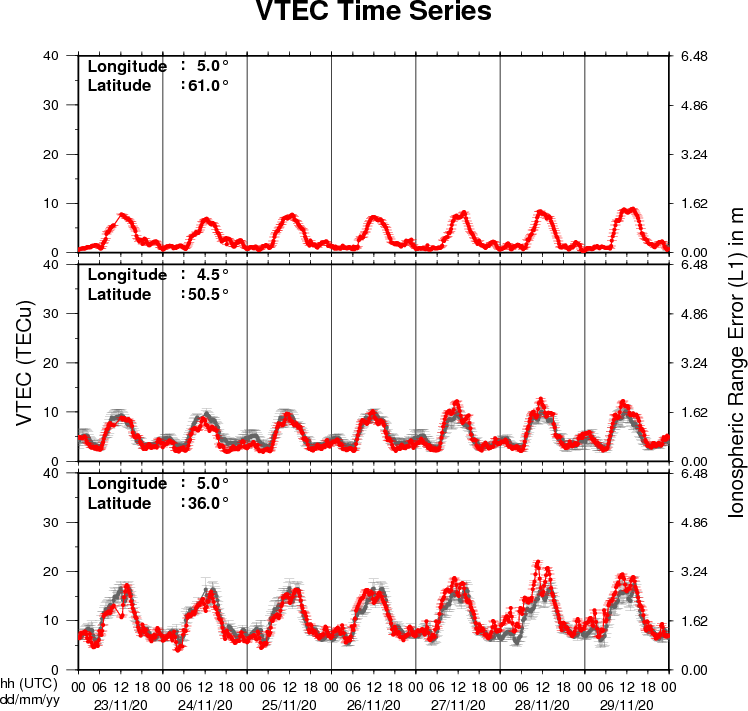
The figure shows the time evolution of the Vertical Total Electron Content (VTEC) (in red) during the last week at three locations:
a) in the northern part of Europe(N61°, 5°E)
b) above Brussels(N50.5°, 4.5°E)
c) in the southern part of Europe(N36°, 5°E)
This figure also shows (in grey) the normal ionospheric behaviour expected based on the median VTEC from the 15 previous days.
The VTEC is expressed in TECu (with TECu=10^16 electrons per square meter) and is directly related to the signal propagation delay due to the ionosphere (in figure: delay on GPS L1 frequency).
The Sun's radiation ionizes the Earth's upper atmosphere, the ionosphere, located from about 60km to 1000km above the Earth's surface.The ionization process in the ionosphere produces ions and free electrons. These electrons perturb the propagation of the GNSS (Global Navigation Satellite System) signals by inducing a so-called ionospheric delay.
See http://stce.be/newsletter/GNSS_final.pdf for some more explanations ; for detailed information, see http://gnss.be/ionosphere_tutorial.php
Not relevant
We decided to add a news item which is not scientifically relevant. Unusual times ask for unusual contributions.
Below you see a crowded picture.

Can you find Wally who looks like this

Maybe next week, we will add a news item in this category which is slightly more scientifically relevant.
Have fun.
